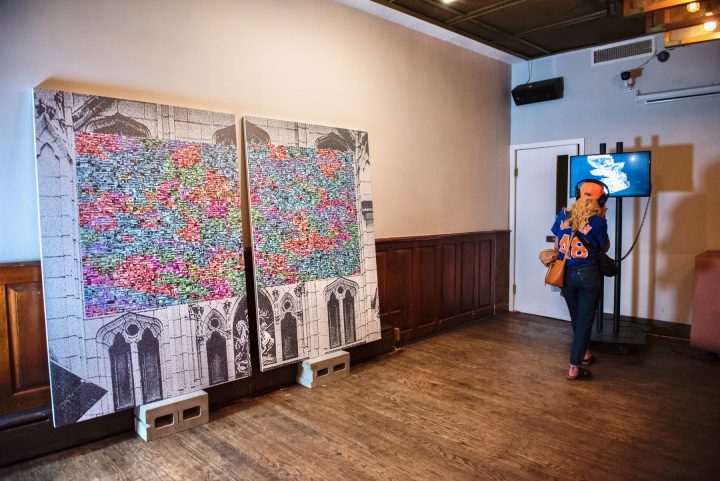
On September 10, the eve of the 20th anniversary of the 2001 attacks, I was intrigued to learn that two well-known artists — filmmaker Laura Poitras and photographer Sean Vegezzi — had arranged a two-day group show, Parallel Construction, at a place I knew well: St. George’s Syrian Catholic Church, only a few blocks south of the World Trade Center. Now a Chinese restaurant, the former church at 103 Washington Street, whose elaborate façade was installed in 1930, is one of the last traces of the historic “Little Syria” neighborhood of lower Manhattan. Until it was largely destroyed by Robert Moses to build the Battery Tunnel in the 1940s, the area was the economic and cultural center of Arab life in the United States for 60 years. For over a decade now, I have worked with a motley collection of local historians and preservationists to protect the last handful of historic buildings in the area.
There is also a broad phenomenon of people who have channeled their feelings of trauma after September 11 — and anger at the militarized response — into major life decisions, including devotion to cultural engagement with Arabs and Muslims or involvement in politics. The preservationists of “Little Syria” certainly fall into this category, and one sees it in several artists involved with the show, including Laura Poitras herself, whose journalism on the Snowden case and critical filmmaking apparently led the United States government to consider classifying her as an “information broker” rather than as a “journalist,” potentially justifying her arrest, or worse.
The show brought together works that explored both the political and personal implications of September 11. The connection between September 11 and Little Syria, in their close physical proximity, has always been a fraught topic. People have debated whether the neighborhood’s memory should be seized upon to tell truthful and positive stories about Arabs in the US, or whether any conflation between its history and contemporary politics is inappropriate. The September 11 Museum notably refused to mention the neighborhood in its required section on local history, and members of the largely Christian Lebanese and Syrian communities descended from early immigrants have been divided about the wisdom of telling family stories to dispel stereotypes about Muslims, whom they may not identify with. Looking around the show with its intense themes about war, surveillance, and trauma, I asked myself whether the location was proof that the mission of promoting the memory of the former Little Syria as a cultural salve had been excessively politicized.
After reflection, I realized how the obscurity and unsettled significance of this lost neighborhood are what made it appealing as a setting to express complex and broadly shared feelings of loss related to September 11, emotions related to historical nostalgia. Despite the endless commentary about September 11 and its aftermath, people still have difficulty confronting its widespread emotional toll. The catastrophe itself and the wars that followed brought collective trauma on a mass scale, and while many experienced physical loss in horrific forms, entire generations also feel a degree of personal loss and a wistful, sometimes naïve, yearning for other possibilities or for a return to an imagined, simpler past. Little Syria has become, more than a historical place, a launching point for its own analogous creative dreaming. Such visions have been expressed in literature in The Thirty Names of Night by Zeyn Joukhadar and The Golem and the Jinni by Helene Wecker, as well as in musical theater by Omar Offendum.
The show’s banner piece by media artist Hasan Elahi illustrated both the personal and political ruptures of September 11 as they relate to “place.” Elahi, who exhaustively documented his daily life after being detained under false suspicion and placed on a terrorist watch list, offered a photograph of the once holy St. George’s in Little Syria covered by the banal images he regularly sent to the FBI hoping to establish his “normality” as a proof of innocence. These included his meals and even his toilet. Just as Little Syria’s normality is lost forever, we suspect Elahi’s is as well.
The show also prompted thinking about more quotidian forms of trauma and loss. Seeking to emphasize the emotions of everyday life in New York City after September 11, Lorenzo Bueno translated into English his mother’s Spanish-language diaries of the following bruised and bewildering year. I found other engagements with the loss of place and historical memory on September 11. Exploring the sheer scale of the Port Authority’s historical archive destroyed in the attacks, Rose Salane reminded me of the implications of forever losing such tangible records of past experiences and past work. Christian Hincapié connected Minoru Yamasaki’s original architectural drawing of a massive World Trade Center “tree” or “trident” to a flattened penny souvenir that he obtained on a memorable childhood visit with his father, emphasizing how individual experiences of the enormous creation still took place at a relatable human scale.

Complex, transformed places such as Little Syria and the World Trade Center prompt valuable artistic insights about loss and about hope for alternative possibilities. In bringing a variety of artistic expressions of human loss to a lost and demolished Arab neighborhood, Parallel Construction offered a type of catharsis for the other victims of September 11, those who were harmed, or merely struggled with collective trauma, in its aftermath.
0 Commentaires